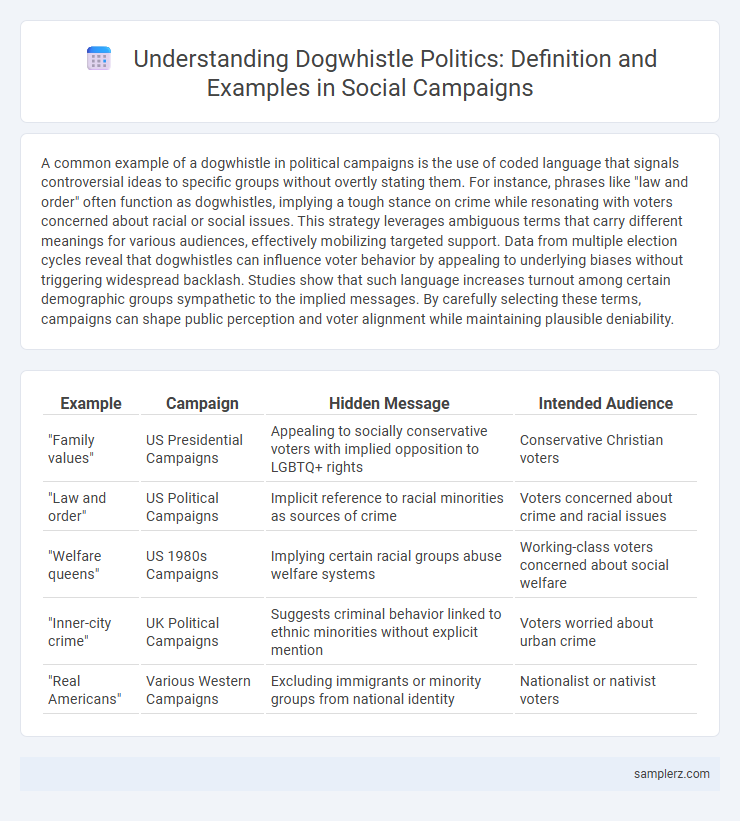A common example of a dogwhistle in political campaigns is the use of coded language that signals controversial ideas to specific groups without overtly stating them. For instance, phrases like "law and order" often function as dogwhistles, implying a tough stance on crime while resonating with voters concerned about racial or social issues. This strategy leverages ambiguous terms that carry different meanings for various audiences, effectively mobilizing targeted support. Data from multiple election cycles reveal that dogwhistles can influence voter behavior by appealing to underlying biases without triggering widespread backlash. Studies show that such language increases turnout among certain demographic groups sympathetic to the implied messages. By carefully selecting these terms, campaigns can shape public perception and voter alignment while maintaining plausible deniability.
Table of Comparison
| Example | Campaign | Hidden Message | Intended Audience |
|---|---|---|---|
| "Family values" | US Presidential Campaigns | Appealing to socially conservative voters with implied opposition to LGBTQ+ rights | Conservative Christian voters |
| "Law and order" | US Political Campaigns | Implicit reference to racial minorities as sources of crime | Voters concerned about crime and racial issues |
| "Welfare queens" | US 1980s Campaigns | Implying certain racial groups abuse welfare systems | Working-class voters concerned about social welfare |
| "Inner-city crime" | UK Political Campaigns | Suggests criminal behavior linked to ethnic minorities without explicit mention | Voters worried about urban crime |
| "Real Americans" | Various Western Campaigns | Excluding immigrants or minority groups from national identity | Nationalist or nativist voters |
Understanding Dogwhistle Tactics in Political Campaigns
Dogwhistle tactics in political campaigns often involve coded language or symbols that signal specific groups without overtly stating controversial views. For example, phrases like "law and order" or references to "traditional values" can subtly appeal to voters with anxieties about crime or social change while maintaining plausible deniability. Understanding these tactics requires analyzing the underlying messages and the social context that makes such signals effective to targeted audiences.
Historical Examples of Dogwhistles in Election Rhetoric
Historical examples of dogwhistles in election rhetoric include Richard Nixon's 1968 campaign slogan "law and order," which covertly appealed to voters' fears of civil rights protests and urban unrest. Ronald Reagan's use of "welfare queens" signaled racial stereotypes without explicit mention, influencing voter perception on social assistance programs. More recently, campaigns have employed phrases like "states' rights" to subtly invoke opposition to federal civil rights measures while maintaining plausible deniability.
How Coded Language Influences Voter Perception
Coded language or "dogwhistles" in political campaigns, such as phrases like "law and order" or "urban crime," subtly signal specific racial or social biases without explicit statements. These terms influence voter perception by activating unconscious associations and emotions linked to particular groups, shaping opinions while maintaining plausible deniability. Research shows that such messaging can shift voter preferences by appealing to underlying prejudices without alienating broader audiences.
Notorious Dogwhistle Phrases Used by Politicians
Law and order" often operates as a notorious dogwhistle in political campaigns, subtly signaling tough stances on crime while appealing to racial biases. Phrases like "welfare queens" evoke stereotypes targeting marginalized communities without overtly referencing race. Politicians deploy terms such as "urban crime" to indirectly associate specific groups with criminal behavior, influencing voter perceptions under the guise of policy concerns.
Case Studies: Dogwhistle Messaging in Modern Campaigns
In modern political campaigns, dogwhistle messaging often employs coded language to resonate with specific voter bases without overt statements, such as the use of "law and order" rhetoric to subtly appeal to fears about crime within marginalized communities. The 2016 U.S. presidential election saw examples where phrases like "inner-city violence" were deployed to signal tough-on-crime stances while implicitly targeting racial groups. Studies reveal that these dogwhistles influence voter perceptions by reinforcing implicit biases, enabling campaigns to mobilize supporters through nuanced messaging without explicit discriminatory language.
The Impact of Subtle Messaging on Social Groups
Dogwhistle messaging in campaigns strategically uses ambiguous language to target specific social groups without overtly offending others, often reinforcing existing biases. Subtle cues in slogans or speeches activate underlying prejudices among certain demographics, influencing voter behavior and social polarization without clear acknowledgment. This covert communication deepens social divides by normalizing exclusionary attitudes under the guise of mainstream political discourse.
Media’s Role in Amplifying Dogwhistle Strategies
Media outlets often amplify dogwhistle strategies in political campaigns by selectively highlighting ambiguous language that resonates with targeted voter bases without explicitly stating controversial views. By repeating coded messages, such as phrases referencing "law and order" or "urban crime," media platforms inadvertently legitimize these signals, increasing their reach and impact. This amplification can polarize public opinion and obscure the true intent behind campaign rhetoric.
How Dogwhistle Signals Target Specific Audiences
Dogwhistle signals in campaigns use coded language that resonates with target specific audiences while appearing innocuous to others, enabling politicians to convey controversial messages indirectly. Phrases like "law and order" often appeal to voters concerned about crime without explicitly mentioning race, creating shared understanding within a subgroup. This subtle communication strategy maximizes voter mobilization by signaling values and priorities that align with particular demographic or ideological groups.
Counteracting Dogwhistle Politics: Social Responses
Social movements and watchdog organizations have increasingly exposed dogwhistle tactics in political campaigns by analyzing coded language and symbols used to subtly target specific voter groups. Public awareness campaigns and fact-checking initiatives mobilize voters to recognize and challenge these indirect appeals, fostering greater electoral transparency. Community dialogues and social media activism amplify marginalized voices, promoting accountability and reducing the effectiveness of dogwhistle strategies.
Recognizing and Decoding Dogwhistles in Campaign Discourse
Campaign discourse often employs dogwhistles, subtle phrases like "law and order" or "welfare reform," which carry concealed meanings targeted at specific voter groups. Recognizing dogwhistles requires understanding the socio-political context and decoding coded language that superficially appears neutral but signals exclusion or bias. Effective analysis of campaign messaging exposes these hidden cues, enabling voters to critically assess underlying intentions and rhetoric.

example of dogwhistle in campaign Infographic
 samplerz.com
samplerz.com